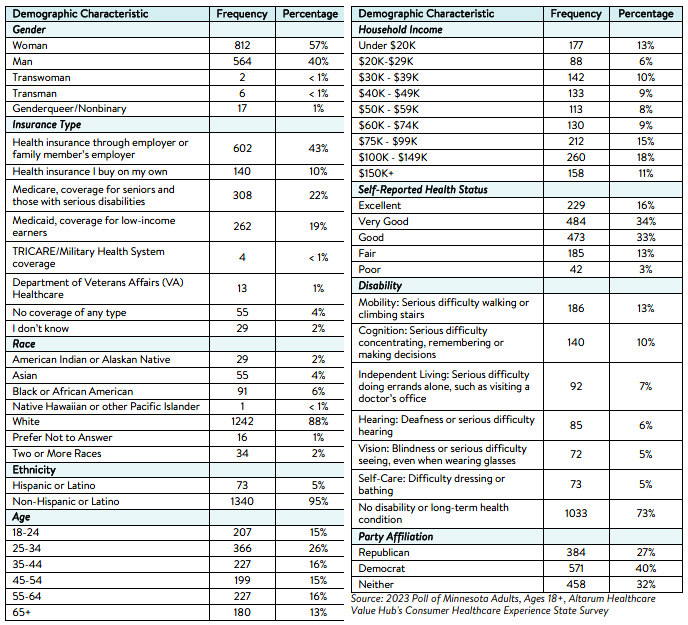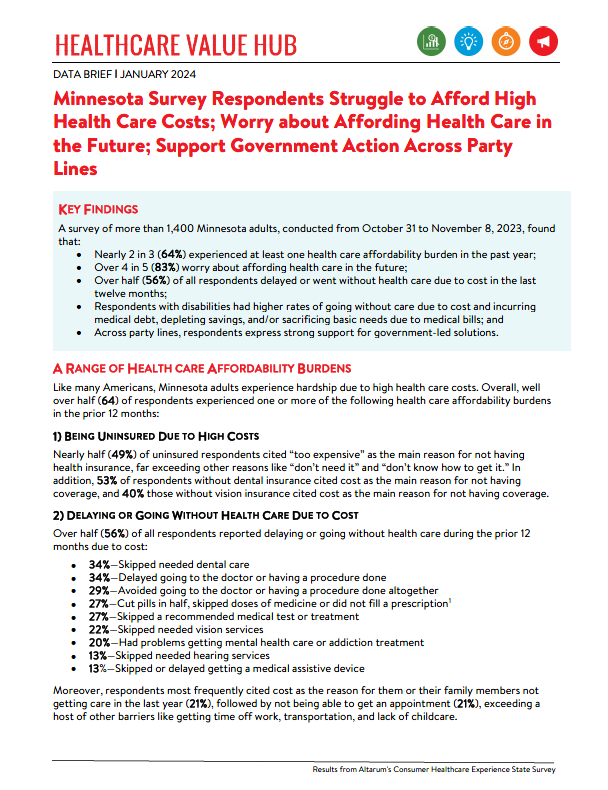Minnesota Survey Respondents Struggle to Afford High Health Care Costs; Worry about Affording Health Care in the Future; Support Government Action Across Party Lines
Key Findings
A survey of more than 1,400 Minnesota adults, conducted from October 31 to November 8, 2023, found
that:
- Nearly 2 in 3 (64%) experienced at least one health care affordability burden in the past year;
- Over 4 in 5 (83%) worry about affording health care in the future;
- Over half (56%) of all respondents delayed or went without health care due to cost in the last twelve months;
- Respondents with disabilities had higher rates of going without care due to cost and incurring medical debt, depleting savings, and/or sacrificing basic needs due to medical bills; and
- Across party lines, respondents express strong support for government-led solutions.
A Range of Health Care Affordability Burdens
Like many Americans, Minnesota adults experience hardship due to high health care costs. Overall, well
over half (64) of respondents experienced one or more of the following health care affordability burdens
in the prior 12 months:
1) Being Uninsured Due to High Costs
Nearly half (49%) of uninsured respondents cited “too expensive” as the main reason for not having
health insurance, far exceeding other reasons like “don’t need it” and “don’t know how to get it.” In
addition, 53% of respondents without dental insurance cited cost as the main reason for not having
coverage, and 40% those without vision insurance cited cost as the main reason for not having coverage.
2) Delaying or Going Without Health Care Due to Cost
Over half (56%) of all respondents reported delaying or going without health care during the prior 12
months due to cost:
- 34%—Skipped needed dental care
- 34%—Delayed going to the doctor or having a procedure done
- 29%—Avoided going to the doctor or having a procedure done altogether
- 27%—Cut pills in half, skipped doses of medicine or did not fill a prescription1
- 27%—Skipped a recommended medical test or treatment
- 22%—Skipped needed vision services
- 20%—Had problems getting mental health care or addiction treatment
- 13%—Skipped needed hearing services
- 13%—Skipped or delayed getting a medical assistive device
Moreover, respondents most frequently cited cost as the reason for them or their family members not
getting care in the last year (21%), followed by not being able to get an appointment (21%), exceeding a
host of other barriers like getting time off work, transportation, and lack of childcare.
3) Struggling to Pay Medical Bills
Other times, respondents got the care they needed but struggled to pay the resulting bill. More than two
in five (41%) of respondents reported experiencing one or more of these struggles to pay their medical
bills:
- 20%— Used up all or most of their savings
- 16%— Were contacted by a collection agency
- 16%— Were unable to pay for basic necessities like food, heat or housing
- 14%— Incurred large amounts of credit card debt
- 11%— Borrowed money, got a loan or another mortgage on their home
- 10%— Were placed on a long-term payment plan
Of the various types of medical bills, the ones most frequently associated with an affordability barrier
were doctor bills, prescription drugs, and dental bills. The high prevalence of affordability burdens for
these services likely reflects the frequency with which Minnesota respondents seek these services.
Trouble paying for dental bills likely reflects lower rates of coverage for these services (25% said they
were partially or completely without dental coverage in the past year).
High Levels of Worry About Affording Health Care in the Future
Minnesota respondents also exhibit high levels of worry about affording health care in the future. Over
four in five (83%) reported being “worried” or “very worried” about affording some aspect of health care
in the future, including:
- 67%—Cost of nursing home or home care services
- 65%—Medical costs when elderly
- 65%—Health insurance will become unaffordable
- 63%—Medical costs in the event of a serious illness or accident
- 53%—Prescription drugs will become unaffordable
- 54%—Cost of dental care
- 43%—Cost of needed vision services
- 43%—Cost of needed hearing services
While two of the most common worries—affording the cost of nursing home or home care services and
medical costs when elderly—are applicable predominantly to an older population, they were most
frequently reported by respondents ages 35-54. This finding suggests that Minnesota respondents may be worried about affording the cost of care for both aging relatives and themselves.
Worry about affording health care was high among all respondents, regardless of income level. However,
worry was highest among those living in households with a person with a disability and those living in
Northern Minnesota (see Table 1). Overall, 88% of respondents with household incomes between $75,000 and $100,000 reported worrying about affording some aspect of coverage or care in the past year, as did 84% of those earning more than $100,000 a year.2 Still, most Minnesota respondents of all incomes, races, ethnicities, geographic setting, and levels of ability were somewhat or very concerned.
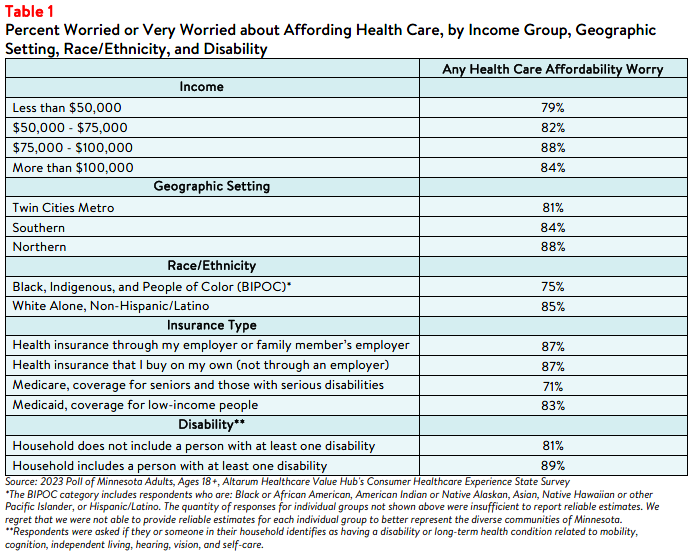
Concern that health insurance will become unaffordable is also more prevalent among certain groups of
Minnesota respondents. By insurance type, respondents with coverage that they have purchased on their
own, not through an employer, most frequently reported worrying about affording coverage, followed by
respondents with coverage through their employer and those with Medicaid coverage (see Figure 1).
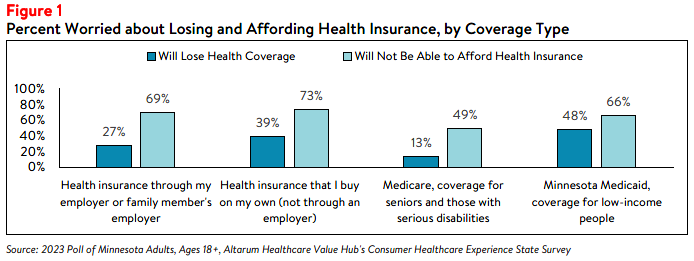
Respondents with household incomes below $50,000 per year reported the highest rates of worry about
losing coverage, while those earning $75,000 to $100,000 reported the highest rates of worrying about
not being able to afford coverage in the future (see Table 2). Respondents living in households with a
person with a disability reported higher rates of being concerned about losing health insurance than those
living in a household without a person with a disability.
Respondents living in Northern Minnesota reported the highest rate of worry about affording insurance in
the future compared to residents in the Twin City Metro and Southern Minnesota. Concerns about
affording coverage exceeded fears about losing coverage across all income groups, disability statuses,
geographic settings, races/ethnicities, and coverage types.
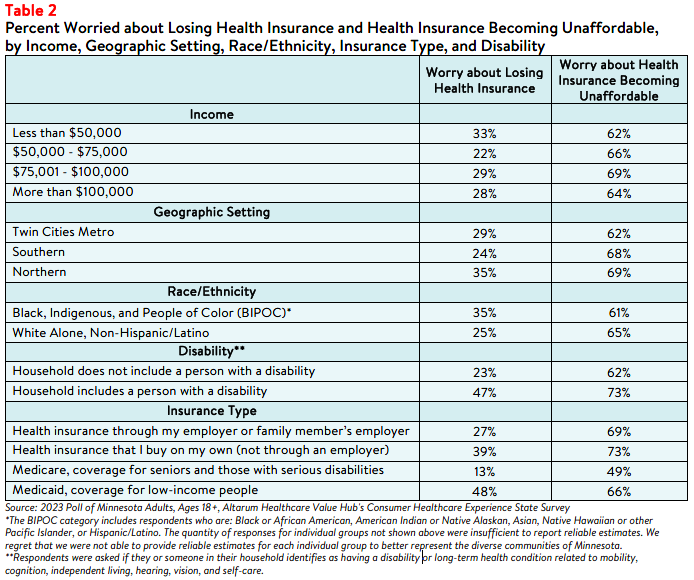
Differences in Health Care Affordability Burdens
The survey also revealed differences in how Minnesota respondents experience health care affordability
burdens by income, age, geographic setting, race/ethnicity, and disability.
Income and Age
Unsurprisingly, respondents at the lowest end of the income spectrum most frequently reported
experiencing one or more health care affordability burdens, with nearly three-fourths (72%) of those
earning less than $50,000 per year reporting struggling to afford some aspect of coverage or care in the
past 12 months (see Figure 2). This may be due, in part, to respondents in this income group reporting higher rates of going without care and rationing their medication due to cost (see Figure 3).
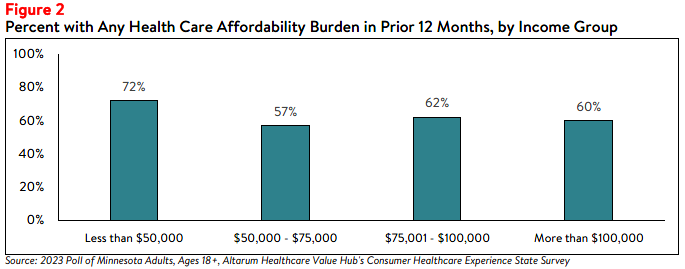
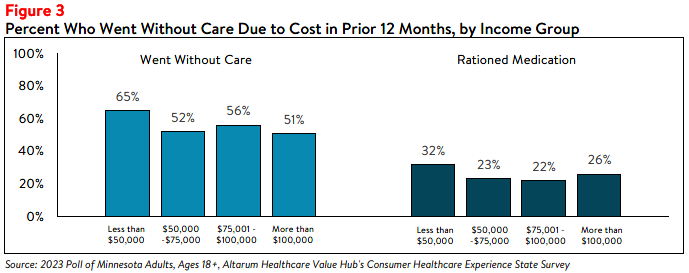
Further analysis found that Minnesota respondents ages 18-44 reported higher rates of going without
care due to cost than respondents ages 45 and older (see Figure 4). Respondents ages 18-44 also most
frequently reported rationing medication due to cost compared to other age groups.
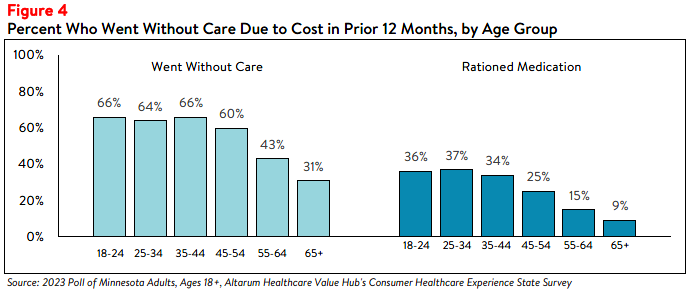
Disability
Respondents living in households with a person with a disability reported the highest rates of going
without care and rationing medication due to cost in the past 12 months. Nearly three in four (74% of)
respondents in this group reported going without some form of care and 45% reported rationing
medication, compared to 50% and 21% of respondents living in households without a person with a
disability, respectively (see Table 4). Respondents living in households with a person with a disability also
more frequently reported delaying or skipping getting mental health care, dental care, and vision services
among other health care services, than those in households without a person with a disability due to cost
concerns (see Table 3).
Those with disabilities also face health care affordability burdens unique to their disabilities—31% of
respondents with a disabled household member reported delaying getting a medical assistive device such
as a wheelchair, cane/walker, hearing aid, or prosthetic limb due to cost. Just 7% of respondents without a
person with a disability in their household (who may have needed such tools temporarily or may not
identify as having a disability) reported this experience.

Insurance Type
Respondents with Minnesota Medicaid coverage reported the highest rates of going without care due to
cost and rationing medication, followed by respondents with private insurance from an employer or
purchased independently (see Table 4). Still, nearly two-fifths (39%) of respondents with Medicare
coverage also went without care due to cost in the twelve months prior to taking the survey.
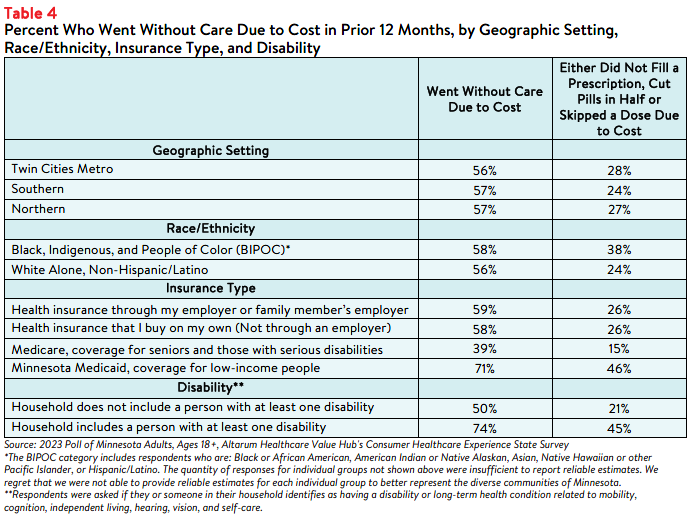
Survey respondents also had the opportunity to share their own stories about going without care due to
cost in the past year. Notably, respondents with both private insurance and Medicaid coverage reported
challenges affording care (see Table 5).
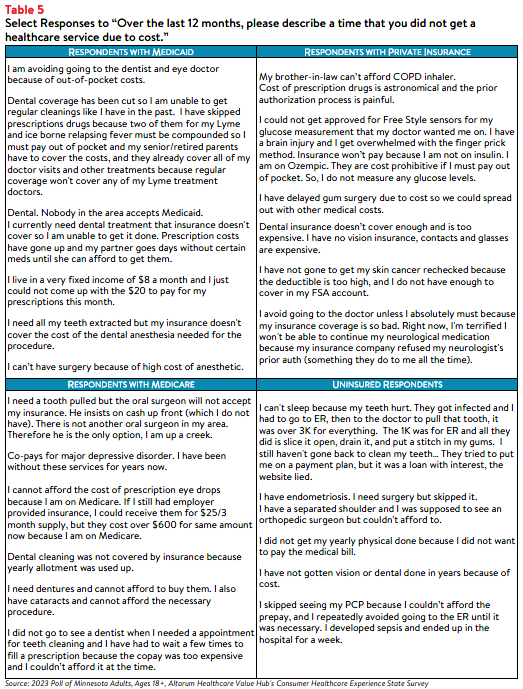
Race and Ethnicity
Black, Indigenous, and other respondents of color reported higher rates of rationing medication and
forgoing care than white alone, non-Hispanic/Latino respondents. Although the sample sizes for African
American and Hispanic respondents did not meet our threshold for reporting, 58% of BIPOC respondents
and 56% of white alone, non-Hispanic/Latino respondents reported going without care due to cost in the
past twelve months compared to (see Table 4). Further analysis showed that BIPOC respondents reported higher rates of rationing medication and avoiding going to the doctor or getting a procedure done due to cost (see Figure 5).
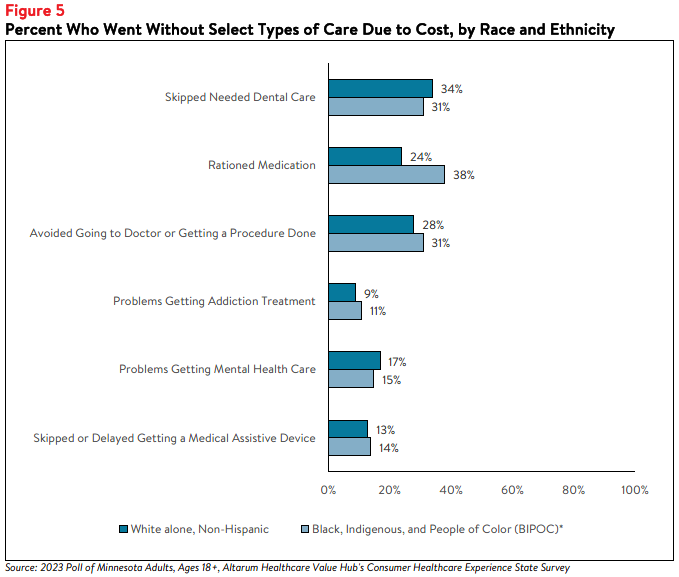
Encountering Medical Debt
The survey also showed differences in the prevalence of financial burdens due to medical bills, including
going into medical debt, depleting savings, and being unable to pay for basic necessities (like food, heat,
and housing) by income, race, ethnicity, disability status, and geographic setting. Fifty-two percent of
Black, Indigenous, and other respondents of color reported going into debt, depleting savings, or going
without other needs due to medical bills, compared to 38% of white alone, non-Hispanic/Latino
respondents (see Table 6).
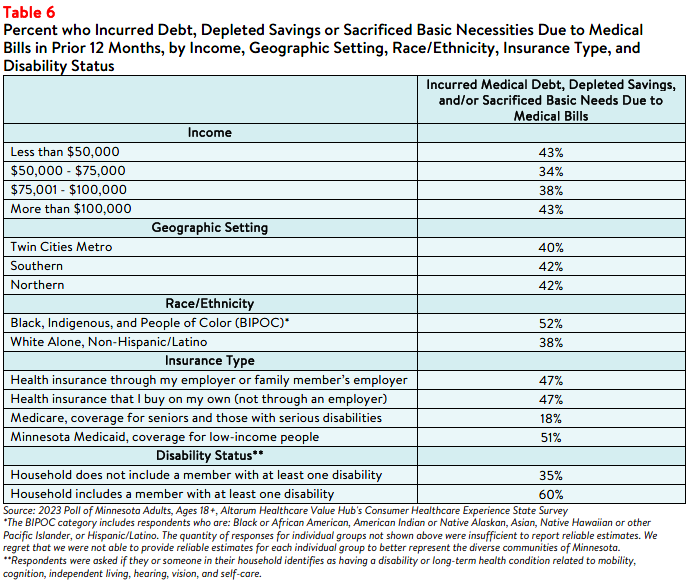
The rate of financial burden is even higher for respondents who have or live with a person with a disability,
with three-fifths (60%) reporting going into debt or going without other needs due to medical bills,
compared to 35% of respondents without a disabled household member. Geographically, residents in
Southern and Northern Minnesota reported higher rates of going into debt or going without other needs
due to medical bills than respondents in the Twin Cities Metro, although all geographic groups reported
somewhat similar levels. In addition, respondents with Medicaid coverage reported the highest rate of the
above financial burdens due to medical bills (51%) compared to respondents with all other insurance types.
Impact of Hospital Consolidation
In addition to the above healthcare affordability burdens, the survey revealed that a small share of
Minnesota respondents were negatively impacted by health system consolidation.3 From 2016 to 2023,
there were 22 changes in ownership involving hospitals through mergers, acquisitions, or changes of
ownership (CHOW) in Minnesota.4,5 Minnesota requires that the state Attorney General be notified of
nonprofit healthcare mergers and acquisitions, but the attorney general does not have the authority to
review, approve, or deny transactions based on broad criteria including public interest and antitrust
review.6
In the past year, 29% of respondents reported that they were aware of a merger or acquisition in their
community—of those respondents, 24% reported that they or a family member were unable to access
their preferred health care organization because of a merger that made their preferred organization out-
of-network. Out of those who reported being unable to access their preferred healthcare provider due to
a merger, respondents reported a variety of new issues occurring due to mergers, including:
- 59%— I skipped recommended follow-up visits due to a merger
- 47%— I delayed going to the doctor or having a procedure done because they could no longer access my preferred health care organization due to a merger
- 36%— I changed my health plan coverage to include the preferred doctor or hospital
Out of those who reported that the merger caused an additional burden for them or their families, the top
three most frequently reported issues were:
- 48%— The merger created an added wait time burden when searching for a new provider
- 22%— The merger created an added financial burden
- 12%— The merger created an added transportation burden
While a small portion of respondents reported being unable to access their preferred health care
organization because of a merger, far more respondents (57%) reported that they would be somewhat,
moderately or very worried about the impacts of mergers in their health care organizations if they were to
occur. When asked about their largest concern respondents most frequently reported:
- 26%— I’m concerned I will have to pay more to see my doctor
- 24%— I’m concerned my doctor may no longer be covered by my insurance
- 23%— I’m concerned I will have fewer choices of where to receive care
- 15%—I’m concerned I will have to travel farther to see my doctor
- 12%—I’m concerned I will have a lower quality of care
Dissatisfaction with the Health System and Support for Change
Considering Minnesota respondents’ health care affordability burdens and concerns, it is not surprising
that they are dissatisfied with the health system:
- Just 35% agreed or strongly agreed that “we have a great healthcare system in the U.S.,”
- While 74% agreed or strongly agreed that “the system needs to change."
To investigate further, the survey asked about both personal and governmental actions to address health
system problems.
Personal Actions
Minnesota respondents see a role for themselves in addressing health care affordability. When asked
about specific actions they could take:
- 50% of respondents reported researching the cost of a drug beforehand, and
- 81% said they would be willing to switch from a brand name to an equivalent generic drug if given the chance.
When asked to select the top three personal actions they felt would be most effective in
addressing health care affordability (out of ten options), the most common responses were:
- 69%— Take better care of my personal health
- 38%— Research treatments myself before going to the doctor
- 31%— Do more to compare doctors on cost and quality before getting services
Government Actions
But far and away, Minnesota respondents see government as the key stakeholder that needs to act to
address health system problems. Moreover, addressing health care problems is one of the top priorities
that respondents want their elected officials to work on.
At the beginning of the survey, respondents were asked what issues the government should address in the upcoming year. The top vote getters were:
- 49%— Health care
- 38%— Economy/Joblessness
- 37%— Taxes
When asked about the top three health care priorities the government should work on, the top responses include:
- 55%— Address high health care costs, including prescription drugs
- 37%— Preserve consumer protections such as preventing people from being denied coverage or charged more for having a pre-existing medical condition
- 35%— Offering health insurance coverage options to residents who cannot afford other coverage
- 28%— Medicare
Of more than 20 options, Minnesota respondents believe the reason for high health care costs is unfair
prices charged by powerful industry stakeholders:
- 78%— Drug companies charging too much money
- 71%— Hospitals charging too much money
- 68%— Insurance companies charging too much money
When it comes to tackling costs, respondents endorsed a number of strategies, including:
- 94%— Require drug companies to provide advanced notice of price increases and information to justify those increases
- 94%— Show what a fair price would be for specific procedures
- 93%— Require insurers to provide up-front cost estimates to consumers
- 92%— Cap out-of-pocket costs for life-saving medications, such as insulin
- 92%— Expand health insurance options so that everyone can afford quality coverage
- 92%— Set standard prices for drugs to make them affordable
Support for Action Across Party Lines
There is also remarkable support for change regardless of respondents' political affiliation (see Table 7).
The high burden of health care affordability, along with high levels of support for change, suggest that
elected leaders and other stakeholders need to make addressing this consumer burden a top priority.
Annual surveys can help assess whether progress is being made.
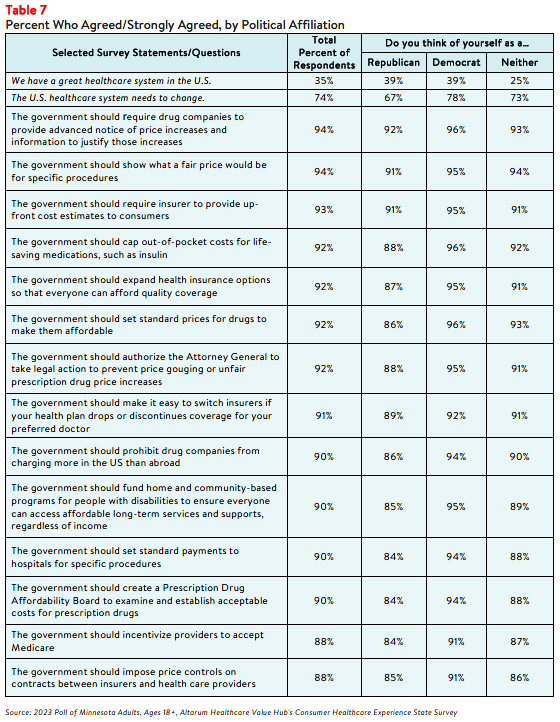
Notes
- Twenty-one percent (21%) did not fill a prescription and 17% cut pills in half or skipped doses of medicine due to cost.
- Median household income in Minnesota was $84,313 (2018-2022). U.S. Census, Quick Facts. Retrieved from: U.S. Census Bureau QuickFacts, https://www.census.gov/quickfacts/fact/.
- The sample size of respondents who said they were affected by a merger was not large enough to report reliable
estimates, so the values in this section should be interpreted with caution. - Centers for Medicare and Medicaid Services. (2023). Hospital Change of Ownership. Retrieved December 8, 2023, from https://data.cms.gov/provider-characteristics/hospitals-and-other-facilities/hospital-change-of-ownership.
- A CHOW typically occurs when a Medicare provider has been purchased (or leased) by another organization. The CHOW results in the transfer of the old owner's identification number and provider agreement (including any Medicare outstanding debt of the old owner) to the new owner. An acquisition/merger occurs when a currently enrolled Medicare provider is purchasing or has been purchased by another enrolled provider. Only the purchaser's CMS Certification Number (CCN) and tax identification number remain. Acquisitions/mergers are different from CHOWs. In the case of an acquisition/merger, the seller/former owner's CCN dissolves. In a CHOW, the seller/former owner's CCN typically remains intact and is transferred to the new owner. A consolidation occurs when two or more enrolled Medicare providers consolidate to form a new business entity. Consolidations are different from acquisitions/mergers. In an acquisition/merger, two entities combine but the CCN and tax identification number (TIN) of the purchasing entity remains intact. In a consolidation, the TINs and CCN of the consolidating entities dissolve and a new TIN and CCN are assigned to the new, consolidated entity. Source: Missouri Department of Health and Senior Services, Change of Ownership Guidelines—Medicare/State Certified Hospice. Retrieved August 23, 2023, from
https://health.mo.gov/safety/homecare/pdf/CHOW-Guidelines-
StateLicensedHospice.pdf#:~:text=Acquisitions%2Fmergers%20are %20different%20from%20CHOWs.%20In%20the%2
0case,providers%20consolidate%20to%20form%20a%20new%20business%20entity - The Source on Healthcare Price and Competition, Merger Review, Retrieved December 8, 2023 from
https://sourceonhealthcare.org/market-consolidation/merger-review/
Methodology
Altarum’s Consumer Healthcare Experience State Survey (CHESS) is designed to elicit respondents’ unbiased views on a wide range of health system issues, including confidence using the health system, financial burden and possible policy solutions.
This survey, conducted from October 31 to November 8, 2023, used a web panel from online survey company Dynata with a demographically balanced sample of approximately 1,400 respondents who live in Minnesota. Information about Dynata’s recruitment and compensation methods can be found here. The survey was conducted in English or Spanish and restricted to adults ages 18 and older. Respondents who finished the survey in less than half the median time were excluded from the final sample, leaving 1,413 cases for analysis. After those exclusions, the demographic composition of respondents was as follows,
although not all demographic information has complete response rates:
